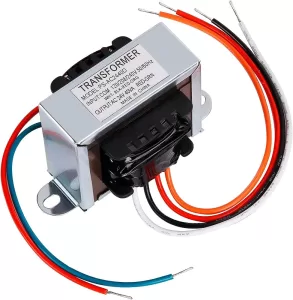
Unveiling A/C Transformer: Everything You Need to Know
November 03 2023 
Inquiry
Global electronic component supplier AMPHEO PTY LTD: Rich inventory for one-stop shopping. Inquire easily, and receive fast, customized solutions and quotes.
QUICK RFQ
ADD TO RFQ LIST
A/C transformers are necessary parts of a lot of electrical and electronic equipment. They change the voltage level of alternating current (AC) to another. Numerous applications, including running motors, charging batteries, and powering appliances, require this. In this blog, we will unveil everything you need to know about A/C transformers. We will discuss how they work, why they require AC, how to test them, how to wire them, and where they are typically located.
What is an A/C Transformer?

Why Does a Transformer Require AC?
Transformers require AC because they use a magnetic field to transfer energy from one circuit to another. AC creates a changing magnetic field, which is necessary for the transformer to work. DC, on the other hand, creates a constant magnetic field. This constant magnetic field does not induce a voltage in the secondary coil of the transformer. Another way to think about it is that transformers work by transferring energy through a process called electromagnetic induction. When a conductor passes through a fluctuating magnetic field, electromagnetic induction takes place. The voltage induced increases with conductor movement speed. The magnetic field changes quickly due to the direction that AC is constantly changing. A voltage is induced in the transformer's secondary coil by this quickly shifting magnetic field. DC, on the other hand, does not change direction. As a result, a quickly shifting magnetic field is not produced. There won't be any voltage induced in the transformer's secondary coil if the magnetic field doesn't change quickly. In conclusion, transformers need AC power because they move energy between circuits using a fluctuating magnetic field. DC does not produce a fluctuating magnetic field; AC does. Here is a simple analogy to help you understand: Consider the transformer as a pump for a bicycle. The inner tube represents the secondary coil, and the piston represents the primary coil. The inner tube's pressure changes as a result of the piston's up and down movements. The tire gets inflated as a result of the inner tube's air moving due to the shifting pressure. AC is comparable to a piston being rapidly raised and lowered. DC functions similarly to a person holding down and pushing the piston. The inner tube's air will remain stationary if you press and hold the piston down, preventing the tire from inflating. Transformers operate in the same way. The magnetic field will remain unchanged and no voltage will be induced in the secondary coil if DC is applied to the primary coil. The primary coil must receive AC to create a voltage in the secondary coil.Video related to A/C Transformer
How Does an A/C Transformer Work?
- Assemble the AC source and primary coil.
- In the core, the magnetic field changes as a result of the AC passing through the primary coil.
- The secondary coil experiences a voltage as a result of the core's fluctuating magnetic field.
- The primary coil's voltage and each coil's number of turns determine the voltage that is induced in the secondary coil.
- Link the secondary coil and the load.
- The secondary coil's induced voltage and the load resistance control the amount of current that flows through the load.
How to Test an A/C Transformer?
Testing an A/C transformer is essential to ensure its proper functioning. Several different testing methods can be used, including:- Multimeter test: A/C transformers can be tested using a multimeter, which is the most popular and simple technique. A multimeter test can be carried out by connecting the leads of the multimeter to the transformer's input and output terminals. Ac voltage should be applied to the input terminals of the multimeter after setting it to AC voltage. Check the transformer's rated voltage by measuring the output voltage. Transistor functionality is confirmed if the output voltage falls within the designated range.
- Insulation resistance test: This test gauges the resistance to insulation between the transformer's core and windings. A megohmmeter should be connected to the transformer's windings and the core to test the insulation resistance. Utilizing the megohmmeter, measure the insulation resistance by applying a voltage. The transformer is operating as intended if the insulation resistance is higher than a predetermined level.
- Load test: This test gauges how well the transformer operates when it is loaded. Connect the transformer to a load and apply AC voltage to the input terminals to conduct a load test. Check the voltage and current at the input and output. Compare the outcomes to the transformer's rated specifications. The transformer is operating correctly if it satisfies or surpasses the rated specifications.
A/C Transformer Wiring
There are two main types of A/C transformer wiring: single-phase wiring and three-phase wiring. Transformers that transfer power from a single-phase power source to a single-phase load are connected using single-phase wiring. In homes and businesses, single-phase power is the power source. Transformers that transfer power from a three-phase power source to a three-phase load are connected using three-phase wiring. The power type utilized in industrial applications is three-phase power. The following are the steps for wiring a single-phase A/C transformer:- Determine the transformer's primary and secondary terminals. The letter "P" or the color red is typically used to identify the primary terminals. The letter "S" or the color black is typically used to identify secondary terminals.
- Attach the transformer's primary terminals to the power supply. A battery, a generator, or a wall outlet can serve as the power source.
- Attach the transformer's secondary terminals to the load. A lightbulb, a motor, or an electronic gadget can all be considered loads.
- Activate the power supply. The voltage from the power source will now be changed by the transformer to the voltage needed by the load.
- Determine the transformer's primary and secondary terminals. The letters "R", "S", and "T" are typically used to identify the primary and secondary terminals of a three-phase transformer.
- Attach the transformer's primary terminals to the power supply. A generator or a three-phase wall outlet can serve as the power supply.
- Attach the transformer's secondary terminals to the load. An electronic gadget or a three-phase motor can be the load.
- Activate the power supply. The voltage from the power source will now be changed by the transformer to the voltage needed by the load.
Where is the A/C Transformer Located?
A/C transformers can be found in a variety of locations, depending on the specific electrical system. Some common locations where A/C transformers are typically installed include:- Power substations
- Industrial facilities
- Residential buildings
- Electronic devices
Applications of A/C Transformers
A/C transformers are used in a wide variety of applications, including:- Powering appliances: Appliances like dryers, washers, and refrigerators are powered by air-conditioning transformers.
- Charging batteries: A/C transformers are used to charge batteries, including those found in laptops and cars.
- Running motors: Compressor and fan motors, among other motors, are powered by A/C transformers.
- Isolating circuits: A/C transformers are a useful tool for separating circuits from one another. This can be helpful to keep noise from one circuit from interfering with another or for safety purposes.
Conclusion
A/C transformers are crucial parts of electrical systems because they provide effective power distribution and voltage conversion. We have discussed several topics related to A/C transformers in this blog, such as wiring configurations, typical locations, the significance of AC voltage, testing procedures, and functionalities. You will be more capable of maintaining, debugging, and optimizing electrical systems that depend on A/C transformers if you have a thorough understanding of these essential parts.Related Articles
- ·Stratix 10 VS Stratix V: Which FPGA is Right for Your Next Project?
- ·Intel Xeon Platinum 8454H vs AMD EPYC: Which Reigns Supreme?
- ·A Deep Dive into the AMD EPYC 4564P Processor
- ·MSP430F5438A vs MSP430F5529: A Detailed Analysis of Their Capabilities
- ·Comparing MSP430F6659 and MSP430F5419A: Which One is Right for Your Project?
- ·Exploring the Features of MSP430F5529 and MSP430F5638 Microcontrollers
- ·Demystifying 20 Microcontroller Projects for Beginners
- ·Unveiling the Ultimate Guide to Microcontroller Programming
- ·4680 Battery: Unveiling the Power Potential of the Next-Gen Cell
- ·Exploring the Case Studies on Arduino Applications
Populer Posts
